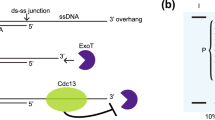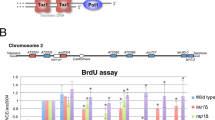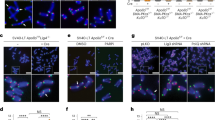Abstract
Genome stability necessitates a mechanism to protect the termini of linear chromosomes from inappropriate degradation or recombination1,2. In many species this protection depends on 'capping' proteins that bind telomeric DNA3,4. The budding yeast Cdc13p binds single-stranded telomeric sequences5,6, prevents lethal degradation of chromosome ends7,8 and regulates telomere extension by telomerase5,9. Two Cdc13-interacting proteins, Stn1p and Ten1p, are also required for viability and telomere length regulation10,11. It has been proposed that Cdc13p DNA binding directs a Cdc13p–Stn1p–Ten1p complex to telomeres to mediate end protection12. However, the functional significance of these protein interactions, and their respective roles in maintaining telomere integrity, remain undefined. Here, we show that co-overexpressing TEN1 with a truncated form of STN1 efficiently bypasses the essential role of CDC13. We further show that this truncated Stn1p binds directly to Pol12p, a polymerase α-primase regulatory subunit, and that Pol12 activity is required for CDC13 bypass. Thus, Stn1p and Ten1p control a Cdc13p-independent telomere capping mechanism that is coupled to the conventional DNA replication machinery.
This is a preview of subscription content, access via your institution
Access options
Subscribe to this journal
Receive 12 print issues and online access
$209.00 per year
only $17.42 per issue
Buy this article
- Purchase on Springer Link
- Instant access to full article PDF
Prices may be subject to local taxes which are calculated during checkout




Similar content being viewed by others
References
Muller, H. J. The remaking of chromosomes. The Collecting Net 13, 181–195 (1938).
McClintock, B. The stability of broken ends of chromosomes in Zea mays. Genetics 41, 234–282 (1941).
Theobald, D. L., Cervantes, R. B., Lundblad, V. & Wuttke, D. S. Homology among telomeric end-protection proteins. Structure 11, 1049–1050 (2003).
Ferreira, M. G., Miller, K. M. & Cooper, J. P. Indecent exposure: when telomeres become uncapped. Mol. Cell 13, 7–18 (2004).
Nugent, C. I., Hughes, T. R., Lue, N. F. & Lundblad, V. Cdc13p: a single-strand telomeric DNA-binding protein with a dual role in yeast telomere maintenance. Science 274, 249–252 (1996).
Lin, J. J. & Zakian, V. A. The Saccharomyces CDC13 protein is a single-strand TG1-3 telomeric DNA-binding protein in vitro that affects telomere behavior in vivo. Proc. Natl Acad. Sci. USA 93, 13760–13765 (1996).
Garvik, B., Carson, M. & Hartwell, L. Single-stranded DNA arising at telomeres in cdc13 mutants may constitute a specific signal for the RAD9 checkpoint. Mol. Cell Biol. 15, 6128–6138 (1995).
Lydall, D. & Weinert, T. Yeast checkpoint genes in DNA damage processing: implications for repair and arrest. Science 270, 1488–1491 (1995).
Smogorzewska, A. & de Lange, T. Regulation of telomerase by telomeric proteins. Annu. Rev. Biochem. 73, 177–208 (2004).
Grandin, N., Reed, S. I. & Charbonneau, M. Stn1, a new Saccharomyces cerevisiae protein, is implicated in telomere size regulation in association with Cdc13. Genes Dev. 11, 512–527 (1997).
Grandin, N., Damon, C. & Charbonneau, M. Ten1 functions in telomere end protection and length regulation in association with Stn1 and Cdc13. EMBO J. 20, 1173–1183 (2001).
Pennock, E., Buckley, K. & Lundblad, V. Cdc13 delivers separate complexes to the telomere for end protection and replication. Cell 104, 387–396 (2001).
Boeke, J. D., LaCroute, F. & Fink, G. R. A positive selection for mutants lacking orotidine-5′-phosphate decarboxylase activity in yeast: 5-fluoro-orotic acid resistance. Mol. Gen. Genet. 197, 345–346 (1984).
Sancar, A., Lindsey-Boltz, L. A., Unsal-Kacmaz, K. & Linn, S. Molecular mechanisms of mammalian DNA repair and the DNA damage checkpoints. Annu. Rev. Biochem. 73, 39–85 (2004).
Taggart, A. K., Teng, S. C. & Zakian, V. A. Est1p as a cell cycle-regulated activator of telomere-bound telomerase. Science 297, 1023–1026 (2002).
Singer, M. S. & Gottschling, D. E. TLC1: template RNA component of Saccharomyces cerevisiae telomerase. Science 266, 404–409 (1994).
Peterson, S. E. et al. The function of a stem-loop in telomerase RNA is linked to the DNA repair protein Ku. Nature Genet. 27, 64–67 (2001).
Fisher, T. S., Taggart, A. K. & Zakian, V. A. Cell cycle-dependent regulation of yeast telomerase by Ku. Nature Struct. Mol. Biol. 11, 1198–1205 (2004).
Le, S., Moore, J. K., Haber, J. E. & Greider, C. W. RAD50 and RAD51 define two pathways that collaborate to maintain telomeres in the absence of telomerase. Genetics 152, 143–152 (1999).
Teng, S. C. & Zakian, V. A. Telomere–telomere recombination is an efficient bypass pathway for telomere maintenance in Saccharomyces cerevisiae. Mol. Cell Biol. 19, 8083–8093 (1999).
Kaina, B. Mechanisms and consequences of methylating agent-induced SCEs and chromosomal aberrations: a long road traveled and still a far way to go. Cytogenet Genome Res. 104, 77–86 (2004).
Koc, A., Wheeler, L. J., Mathews, C. K. & Merrill, G. F. Hydroxyurea arrests DNA replication by a mechanism that preserves basal dNTP pools. J. Biol. Chem. 279, 223–230 (2004).
Miller, K. M. & Cooper, J. P. The telomere protein Taz1 is required to prevent and repair genomic DNA breaks. Mol. Cell 11, 303–313 (2003).
Grossi, S., Puglisi, A., Dmitriev, P. V., Lopes, M. & Shore, D. Pol12, the B subunit of DNA polymerase α, functions in both telomere capping and length regulation. Genes Dev. 18, 992–1006 (2004).
Qi, H. & Zakian, V. A. The Saccharomyces telomere-binding protein Cdc13p interacts with both the catalytic subunit of DNA polymerase α and the telomerase-associated est1 protein. Genes Dev. 14, 1777–1788 (2000).
James, P., Halladay, J. & Craig, E. A. Genomic libraries and a host strain designed for highly efficient two-hybrid selection in yeast. Genetics 144, 1425–1436 (1996).
Chandra, A., Hughes, T. R., Nugent, C. I. & Lundblad, V. Cdc13 both positively and negatively regulates telomere replication. Genes Dev. 15, 404–414 (2001).
Lundblad, V. & Szostak, J. W. A mutant with a defect in telomere elongation leads to senescence in yeast. Cell 57, 633–643 (1989).
Dionne, I. & Wellinger, R. J. Cell cycle-regulated generation of single-stranded G-rich DNA in the absence of telomerase. Proc. Natl Acad. Sci. USA 93, 13902–13907 (1996).
Bertuch, A. A. & Lundblad, V. The Ku heterodimer performs separable activities at double-strand breaks and chromosome termini. Mol. Cell Biol. 23, 8202–8215 (2003).
Acknowledgements
We appreciate helpful input from J. Bachant, A. Grosovsky, D. Lydall, M. Petreaca, R. Wellinger and members of the Nugent laboratory. We thank D. Gottschling, S. Elledge and V. Lundblad for sharing strains and plasmids. We also thank D. Lydall and R. Wellinger for communicating results before publication. This work was funded by a grant from the National Institutes of Health (CIN).
Author information
Authors and Affiliations
Contributions
R.C.P. made the initial bypass observations and performed the two-hybrid analysis and Southern blots. H.C. analysed ssTG and performed the Pol12-related experiments. R.P., P.C. and H.A.E. contributed experiments for cdc13-1 suppression. H.A.E. and C.C. analysed Rad53 shift and provided technical assistance. C.C. performed the DNA damage sensitivity experiments. L.X. analysed the telomere structure. C.I.N. guided experimental design and helped analyse growth phenotypes and bypass in mutant backgrounds. C.I.N. wrote the paper.
Corresponding author
Ethics declarations
Competing interests
The authors declare no competing financial interests.
Supplementary information
Supplementary Information
Supplementary Figures S1, S2, S3, S4 and Supplementary Table S1 (PDF 709 kb)
Rights and permissions
About this article
Cite this article
Petreaca, R., Chiu, HC., Eckelhoefer, H. et al. Chromosome end protection plasticity revealed by Stn1p and Ten1p bypass of Cdc13p. Nat Cell Biol 8, 748–755 (2006). https://doi.org/10.1038/ncb1430
Received:
Accepted:
Published:
Issue Date:
DOI: https://doi.org/10.1038/ncb1430
This article is cited by
-
Yeast Stn1 promotes MCM to circumvent Rad53 control of the S phase checkpoint
Current Genetics (2022)
-
Structural insights into telomere protection and homeostasis regulation by yeast CST complex
Nature Structural & Molecular Biology (2020)
-
Fine tuning the level of the Cdc13 telomere-capping protein for maximal chromosome stability performance
Current Genetics (2019)
-
Human Stn1 protects telomere integrity by promoting efficient lagging-strand synthesis at telomeres and mediating C-strand fill-in
Cell Research (2012)
-
RPA facilitates telomerase activity at chromosome ends in budding and fission yeasts
The EMBO Journal (2012)



